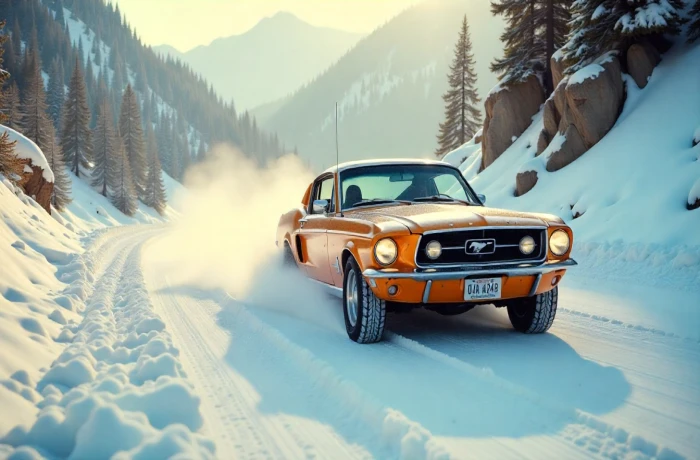What if you could legally get behind the wheel of one of Hollywood’s most famous cars—the 1967 Mustang “Eleanor”?
The Mustang’s place in cinema history is well documented. As the Western Reserve Historical Society notes, iconic models like Steve McQueen’s Bullitt Mustang and Nicolas Cage’s “Eleanor” continue to define the car’s cultural impact.
This post explains how the Gone in 60 Seconds car went from a silver-screen heist target to a collectible you can own or replicate. You will learn the legal paths, technical details, and insider tips collectors use to secure one.
Without these insights, it’s easy to miss the chance to secure one. Learn more about the Gone in 60 Seconds cast, and other iconic cars from the film, such as the Lamborghini Diablo and Cadillac Eldorado.
What You’ll Learn
In this post, you will learn:
How the 1967 “Eleanor” Mustang was created for Gone in 60 Seconds
How to identify an authentic model or a quality replica
How to find current market prices and avoid buying mistakes
Summary
The 1967 Ford Mustang known as "Eleanor" from the 2000 film Gone in 60 Seconds stands as one of cinema's most iconic movie cars. Starring alongside Nicolas Cage as master thief Memphis Raines, this custom Shelby GT500 tribute became the ultimate automotive prize, the 50th and most challenging car on the heist list.
The Movie Car: Not a GT500
Despite its appearance, the movie Eleanor wasn't a genuine 1967 Shelby GT500. Instead, it was a custom build—conceived by Hot Rod illustrator Steve Stanford and executed by legendary designer Chip Foose. The design team used standard 1967 Mustang Fastbacks as donor cars and transformed them with extensive bodywork and custom components.
Key Specifications:
Base: 1967 Ford Mustang Fastback
Paint: Metallic Pepper Gray with black racing stripes
Engine: Various V8 configurations for different movie cars
Body Kit: Custom Shelby-inspired styling by Chip Foose
Distinguishing Features: Side-exit exhausts, auxiliary lights, aggressive front splitter
Multiple Cars for Multiple Roles
The production used 13 different Mustangs to portray Eleanor throughout filming. Each car was tailored for specific types of scenes:
Beauty cars for close-ups and interior scenes
Stunt cars for chase sequences and jumps
Driving vehicles for highway scenes
Crash cars for destruction sequences
This approach allowed filmmakers to preserve the hero cars while capturing the intense action sequences that made the movie memorable.
The Original Eleanor: 1974 vs. 2000
The Eleanor name originated in the 1974 film Gone in 60 Seconds by H.B. "Toby" Halicki. However, the two cars couldn't be more different:
1974 Eleanor
Car: 1971 Ford Mustang Sportsroof modified to look like a 1973 model
Paint: A budget-friendly “school bus yellow”
Claim to Fame: 40-minute chase scene destroying 93 vehicles
Reality: Only two cars used, one for stunts, one for beauty shots
2000 Eleanor
Car: 1967 Mustang Fastback with custom GT500 styling
Paint: Sophisticated Pepper Gray metallic
Designer Pedigree: Steve Stanford design, Chip Foose execution
Cultural Impact: Spawned thousands of replicas worldwide
Building a Real Eleanor Today
Modern Eleanor tributes typically start with a 1967-68 Mustang Fastback donor car and require extensive modifications:
Typical Build Specifications:
Starting Price: $249,000+ for professional builds
Engine Options: 427 Roush V8 (560 HP), 750+ HP available
Transmission: Six-speed manual (Tremec TKX)
Body: 100% carbon fiber body kit components
Suspension: Detroit Speed front/rear systems
Weight: 3,300-3,700 lbs, depending on configuration
Key Components:
Custom front bumper/nose piece
Side fender flares and rockers
Functional hood scoops
Side-exit exhaust system
Roll cage integration
Modern safety systems
Legal Battles and Copyright Issues
The Eleanor name and design have been subject to extensive legal battles lasting over 20 years. In 2025, a U.S. Court of Appeals ruling determined that Eleanor cannot be copyrighted as a character, classifying it instead as a movie prop. This ruling allows replica builders to create Eleanor tributes without legal concerns about copyright infringement.
Performance: Movie Magic vs. Reality
The movie Eleanor was portrayed as a competent performance machine, but the reality varied by specific car:
Movie Performance Claims:
High-speed chases through city streets
Massive jumps (140+ foot bridge jump)
Extreme durability through crashes and impacts
Cultural Impact and Legacy
Eleanor's influence extends far beyond the movie screen:
Replica Industry: Spawned entire businesses building Eleanor tributes
Car Shows: Regular feature at automotive events nationwide
Collectibility: Original movie cars are worth millions if they still exist
Pop Culture: Referenced in music, other films, and car culture
The car represents the perfect blend of classic American muscle car aesthetics with modern performance capabilities, making it appealing to both vintage car enthusiasts and contemporary performance fans.
Eleanor’s Rise to Fame
The movie Gone in 60 Seconds came out again on June 9, 2000. In the film, the main car in the big chase scene was a 1967 Ford Mustang. It was modified to resemble a high-end car, specifically a Shelby GT500. The people who made the movie called this car "Eleanor."
This car gained fame due to its unique design and appearance, as well as its role in the movie. The first Gone in 60 Seconds movie from 1974 used a yellow 1971 Mustang. But when the new film used a late-1960s Mustang that looked like a Shelby, it created a lasting image that car fans and collectors around the world still remember.
Eleanor In The 2000 Film
For the 2000 movie Gone in 60 Seconds, the filmmakers needed a car that looked tough and could handle difficult stunts. They picked the 1967 Ford Mustang Fastback and changed it to look like a Shelby GT500.
An artist named Steve Stanford designed it, and a car builder named Chip Foose built it. Each car was painted metallic pepper gray with black racing stripes. They also had side exhausts, extra front lights, and a custom front spoiler. The body kits made the Mustangs look wider and more angular than regular models.
None of the cars was a real Shelby GT500. They were standard Fastbacks that were modified with fiberglass body panels, updated suspension, and different V8 engines. The engines varied, from basic small-blocks to powerful big-block V8s, depending on what the stunt required.
A total of thirteen “Eleanors” were built for the movie, each serving a specific role:
Beauty cars were used for close-up shots and promotional stills. These had the most detailed interiors, clean engine bays, and flawless bodywork.
Stunt cars were reinforced for jumps, crashes, and high-speed maneuvers. They often carried safety cages, upgraded brakes, and suspension designed for impact.
Driving cars were tuned for smooth, reliable operation in chase sequences and highway scenes. These provide balanced performance with durability for long shooting days.
Crash cars were intentionally prepared for destruction scenes, sometimes with stripped interiors and minimal mechanical investment.
This approach allowed the filmmakers to capture a wide range of shots without risking the higher-value cars during dangerous stunts.
Eleanor in 1974 vs. 2000
The 1974 movie Gone in 60 Seconds featured a yellow 1971 Mustang Sportsroof called "Eleanor." This car gained fame for a 40-minute car chase scene. It looked like a regular car.
When they remade the movie in 2000, they wanted a cooler car from the muscle car era. They chose a 1967 Ford Mustang Fastback and made it look like a Shelby GT500. This made the new "Eleanor" look tougher, like a racing car, and very different from the first one.
The 2000 "Eleanor" was also built differently. The 1974 car was just a regular car used for stunts, but the 2000 cars had special body parts, better suspension (to make the ride smoother and handle better), and different engines for various scenes. This made the car look amazing and perform well on screen.
Changing "Eleanor" for the 2000 movie turned it from just a stunt car into a car that collectors really want. This newer version is now what most car fans think of when they hear the name "Eleanor."
Building a Real Eleanor Today
To build an exact copy of the 'Eleanor' Mustang from the movie, you first need to find a 1967 or 1968 Ford Mustang Fastback. The condition of the car when you start will affect the total cost, the time it takes, and the final appearance of the car. Well-preserved cars cost more up front, while rougher examples require far more time and restoration work.
Making a professional 'Eleanor' usually costs around $249,000. This price covers special bodywork, engine and performance upgrades, and making sure it looks exactly like the movie car, maybe even better. Experienced builders make sure to follow the design from the 2000 movie, including the Metallic Pepper Gray paint, black racing stripes, and exhaust pipes that come out of the side of the car.
Engine choices vary based on performance goals. Common configurations include:
427 Roush V8 producing approximately 560 horsepower for balanced street and show use.
High-output custom V8 builds exceeding 750 horsepower for track-oriented performance.
Upgrades often go beyond aesthetics to improve handling, safety, and reliability. Options may include:
Carbon fiber body panels to reduce weight.
Performance suspension systems for precise cornering.
Roll cages and reinforced chassis for safety.
Four-wheel disc brakes for improved stopping power.
Modern comfort features like air conditioning and infotainment systems are installed discreetly to preserve the classic appearance.
A skilled builder will keep detailed notes and photos of the entire process. This proves the car is real and helps it sell for more later. Choosing a reputable shop that has experience building Eleanor cars can help prevent issues with its performance or appearance.
Eleanor’s Legal History
The 'Eleanor' Mustang from the movie Gone in 60 Seconds has been the subject of numerous legal disputes over ownership rights and the ability to produce replicas. For many years, a company connected to the movie's original creator said they had the only right to use the Eleanor name and look. This led to lawsuits against people who built or owned replicas, which made things uncertain for car collectors.
In 2025, a U.S. court ruled that Eleanor is a movie prop—not a protected character or intellectual property. This decision removed the legal roadblocks that had limited who could make authorized copies. It allowed builders and owners to create, sell, and show Eleanor replicas without needing special licenses tied to the old claims.
Even though the court ruling made the legal situation simpler, it's still important to be careful when buying a car. Buyers should make sure the vehicle they are buying is exactly what it's advertised to be, whether it's a car used in the movie, an officially licensed build, or a copy made independently. Clear paperwork, pictures of how the car was built, and verified lists of its parts can help avoid problems after you buy it.
Collectors also need to know that the 2025 decision only applies in the U.S. Laws about replicas and trademarks can be different in other countries, so buyers outside the United States should check their local rules before ordering or bringing in a replica.
Final Thoughts
The 1967 Mustang called Eleanor from the movie Gone in 60 Seconds is more than just a movie car now. What began as a film prop has become one of the most sought-after movie cars in the world. It's also used as a model for making expensive custom cars. Now, due to recent legal decisions, it's easier to purchase authentic versions of Eleanor without the numerous restrictions on who owns the design rights. This means car fans have more freedom to get one.
If you want to buy or have someone build an Eleanor for you, you need to plan carefully, have a clear budget, and get help from professionals.
Need Help Shipping Your Car?
AmeriFreight Auto Transport works with vetted carriers across the country, experienced in safe and reliable classic car shipping for vehicles like the Eleanor Mustang. Enclosed transport is available to protect your vehicle in transit.
Contact us to arrange pickup and delivery. We make the process straightforward from start to finish.
Frequently Asked Questions (FAQs)
How many “Eleanor” Mustangs were built for the Gone in 60 Seconds film?
Thirteen Eleanor Mustangs were built for the 2000 remake. Each served a specific role, such as beauty shots, stunt work, driving scenes, or crash sequences.
Did Nicolas Cage drive the “Eleanor” Mustang in Gone in 60 Seconds?
Yes. Nicolas Cage completed many of his driving scenes after undergoing stunt training, although professional stunt drivers handled the more dangerous maneuvers.
Who owns the “Eleanor” Mustangs used in Gone in 60 Seconds now?
The surviving movie cars are in private collections, museums, or have been sold at public auctions. Most are not regularly displayed to the public.
How much did the original “Eleanor” Mustang from Gone in 60 Seconds sell for at auction?
One of the main beauty cars from the 2000 film sold at auction for $1 million in 2013. Prices for verified film-used cars can be higher depending on condition and documentation.
Disclaimer: This post is for informational purposes only. It is not legal, financial, or purchasing advice. Always consult qualified professionals before buying, building, or transporting a vehicle.
















